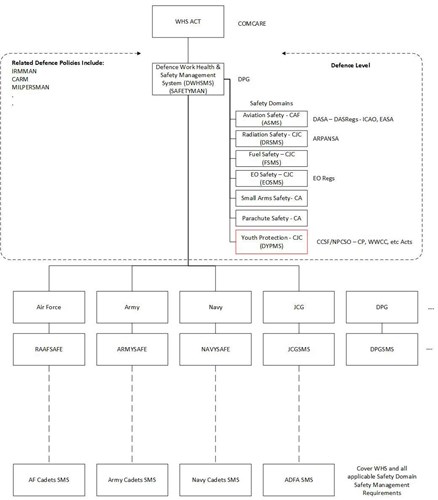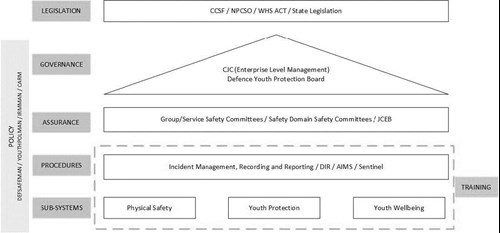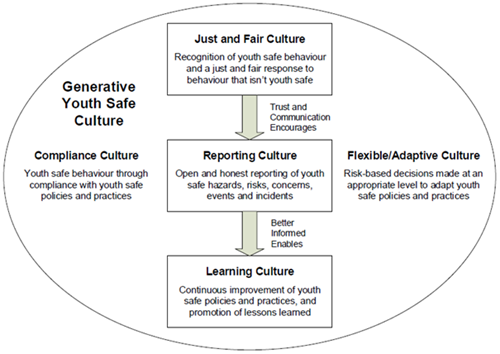4.2.2 The intent of this policy is to ensure that youth protection performance is monitored, measured, analysed, reported and reviewed within the governance framework defined by Defence and subordinate Group/Service Work Health and Safety Management System (WHSMS).
4.2.3 Defence youth protection management policy is consistent with:
a. Requirement 2.0 of the Commonwealth Child Safe Framework (CCSF): Establish and maintain a system of training and compliance, to make staff aware of, and compliant with, the framework and relevant legislation, including Working with Children Checks and mandatory reporting requirements
b. Principle 1 of the National Principles for Child Safe Organisations (NPCSO): Child safety and wellbeing is embedded in organisational leadership, governance and culture
(1) Key Action Area 1.3: Governance arrangements facilitate implementation of the child safety and wellbeing policy at all levels
c. Principle 9 of the NPCSO: Implementation of the national child safe principles is regularly reviewed and improved
(1) Key Action Area 9.1: The organisation regularly reviews, evaluates and improves child safe practices
(2) Key Action Area 9.2: Complaints, concerns and safety incidents are analysed to identify causes and systemic failures so as to inform continuous improvement
(3) Key Action Area 9.3: The organisation reports on the findings of relevant reviews to staff and volunteers, community and families and children and young people
4.2.4 Other Defence publications which may be relevant to this policy include, but are not limited to the Defence WHS Assurance Policy
4.2.5 Youth Protection Performance Management. Youth protection performance management incorporates monitoring, measurement, analysis, reporting and review within the governance framework outlined in Annex A. Youth protection performance management includes processes aimed at assuring:
a. Compliance. Confirmation that policy, processes and risk controls are present and suitable against youth protection requirements
b. Conformance. Confirmation that policy, processes and risk controls are operating, facilitated by a strong and effective youth safe culture
c. Performance. Confirmation that policy, processes and risk controls are effective in eliminating or otherwise minimising youth protection hazards and risks, so far as reasonably practicable, to provide a youth safe environment.
YOUTH PROTECTION PERFORMANCE MONITORING
4.2.6 Chief of Personnel (CPERS), Group Heads and Service Chiefs must ensure that youth protection performance is effectively monitored via a combination of youth protection audits, workplace inspections, surveys and closed-loop hazard and risk tracking as appropriate.
YOUTH PROTECTION AUDITS
4.2.7 Enterprise-Level Youth Protection Audit. Head Reserves and Cadets Support Division (HRCSD) must ensure that enterprise-level youth protection audits are conducted in accordance with Defence WHSMS Audit Policy, applying the following direction:
a. RCSD Audits. At a minimum, desk-top audits must be conducted to confirm that the Defence Youth Protection Management System (DYPMS) complies with the CCSF and Group/Service documentation complies with the Defence DYPMS. Ongoing verification of compliance must be maintained through DYPMS review (see Section 1, Chapter 2) and risk based desk-top audits
b. Other Internal Audits. Audits by other Defence agencies should be coordinated and conducted as appropriate or as directed by the Enterprise Business Committee (EBC).
4.2.8 Group/Service Youth Protection Audits. Group Heads and Service Chiefs must ensure that youth protection audits of applicable subordinate organisations/ units are conducted to assure compliance and conformance with the Group/Service documentation. Youth Protection audits should be risk-based, integrated into Group/Service WHS or other audit programs where practicable and managed in accordance with relevant Group/Service audit policy. A copy or extract of any Group/ Service audit report related to youth protection should be provided to JSSD via the Defence Youth Protection mailbox.
WORKPLACE INSPECTIONS
4.2.9 Commanders, managers and supervisors must ensure that workplace inspections conducted in accordance with Group/Service WHSMS policy consider and address youth protection hazards and risks (see Section 3, Chapter 1) as appropriate.
YOUTH PROTECTION SURVEYS
4.2.10 RCSD Coordinated Youth Protection Surveys. HRCSD must ensure that youth protection surveys are periodically conducted to obtain feedback and analysed to gauge youth protection knowledge, culture and management system effectiveness, as follows:
a. Enterprise-level Surveys. Youth protection should be integrated into enterprise-level safety and/or cultural surveys coordinated by other Defence agencies where practicable
b. Targeted Surveys. Targeted youth protection surveys of Defence youth programs and other contexts where Defence heavily engage with youth must be conducted where practicable. Youth protection surveys should be conducted at least once every three years. The opportunity to participate in a youth protection survey should be provided to the family of youth and the community
c. Communication of Results. The results of all surveys must be communicated to all participants including youth and the community (see Section 5, Chapter 2).
4.2.11 Other Youth Protection Surveys. Commanders, managers and supervisors should ensure that youth protection is integrated into any safety and/or cultural surveys as appropriate.
4.2.12 Ethics Committee Approval. All youth protection related surveys must be approved by the Departments of Defence and Veterans’ Affairs Human Research Ethics Committee or Defence People Group Low Risk Ethics Panel as applicable.
YOUTH PROTECTION HAZARD AND RISK CLOSED-LOOP TRACKING
4.2.13 Commanders, managers and supervisors must ensure that youth protection hazards, risks and associated risk management records are monitored, tracked, reviewed and/or closed as appropriate in accordance with Group/Service WHSMS policy, as follows:
a. Hazard and Risk Monitoring and Review. Youth protection hazards and risks must continue to be monitored until elimination of the hazard and risks/so far as reasonably practicable. Review of youth protection risk controls should be both periodic and event based (see Section 1, Chapter 2 and Section 3, Chapter 1 and Chapter 4)
b. Hazard and Event/Incident Report Closure. Youth protection hazard and event/incident reports must be reviewed for quality and completeness. Actions and recommendations must be tracked to completion before closure of the report.
YOUTH PROTECTION PERFORMANCE MEASUREMENT
4.2.14 Commanders, managers and supervisors at all levels must ensure that youth protection performance for their scope of responsibility is periodically measured against the Key Performance Indicators (KPIs) outlined in Table 1.
| KPI Title |
KPI |
| Youth Protection ConCERNs |
The number of Youth Protection ConCERNs submitted |
| Class A & Class B Youth Protection Events/Incidents |
The number of Class A and Class B youth protection events/incidents that occur in the Defence environment |
| Youth Protection Training |
% of personnel who have completed relevant Defence youth safe training package(s) |
| Suitability Screening and Working with Children Checks |
Youth protection related question(s) are included in selection processes for youth-related work positions.
% of personnel who have required Working with Children Checks clearance |
Table 1: Youth Protection KPIs
YOUTH PROTECTION PERFORMANCE ANALYIS AND REPORTING
4.2.15 Commanders, managers and supervisors at all levels must ensure that youth protection performance for their scope of responsibility is analysed at least twice per annum to align with the Enterprise Business Committee process, aggregated and reported as appropriate and in accordance with Defence and Group/Service WHSMS policy, as follows:
a. Youth Protection Performance Analysis. The outcomes/records of youth protection performance monitoring and measurement must be periodically analysed by safety-related working groups, committees, councils and/or boards as appropriate, to:
(1) identify and address adverse trends, new hazards, deficient risk controls and/or systemic issues
(2) identify and implement initiatives to improve youth protection performance
b. Youth Protection Performance Reporting. The outcome of youth protection performance analysis must be reported to higher organisational levels in accordance with Annex A. A copy or extract of any Group/Service level report or minutes related to youth protection performance should be provided to JSSD via the Defence Youth Protection mailbox
c. Scheduling. Youth protection performance analysis and review should be integrated into broader Defence and Group/Service WHS or other governance arrangements where practicable and scheduled to support youth protection performance review (see paragraphs 4.1.16 to 4.1.18).
YOUTH PROTECTION PERFORMANCE REVIEW
4.2.16 Group/Service Councils/Boards. Group Heads and Service Chiefs must ensure youth protection performance is biannually reviewed in accordance with Service/Group WHS governance policy.
4.2.17 Joint Support Executive Committee. HRCSD must provide secretariat support to the Joint Support Executive Committee (JSEC), which must be conducted biannually in accordance with the terms of reference outlined in Annex B.
4.2.18 Enterprise Business Committee. CPERS shall report Defence youth protection performance to the EBC in June and December of each year.
PRIVACY
4.2.19 All information collected in relation to youth protection performance management policy must be managed in accordance with the privacy requirements outlined in Section 1, Chapter 2.
Annexes
A. Defence Youth Protection Governance Framework
B. Joint Support Executive Committee - Governance Principles





